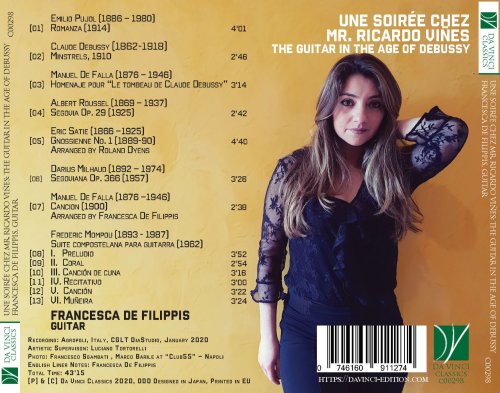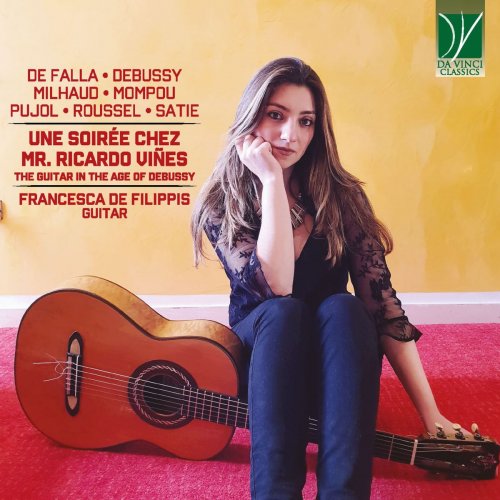
Francesca De Filippis - De Falla, Debussy, Milhaud, Mompou, Pujol, Roussel, Satie: Une soirée chez Mr. Ricardo Viñes (The Guitar in the Age of Debussy) (2020)
BAND/ARTIST: Francesca De Filippis
- Title: De Falla, Debussy, Milhaud, Mompou, Pujol, Roussel, Satie: Une soirée chez Mr. Ricardo Viñes (The Guitar in the Age of Debussy)
- Year Of Release: 2020
- Label: Da Vinci Classics
- Genre: Classical, Guitar
- Quality: FLAC (tracks)
- Total Time: 43:34 min
- Total Size: 147 MB
- WebSite: Album Preview

Tracklist:
01. Romanza
02. Préludes, Premier Livre, CD 125, L.117: No. 12, Minstrels
03. Homenaje pour "Le tombeau de Claude Debussy"
04. Segovia, Op. 29
05. Gnossienne: No. 1, Lent
06. Segoviana, Op. 366
07. Siete canciones populares Españolas
08. Suite compostelana para guitarra: I. Preludio
09. Suite compostelana para guitarra: II. Coral
10. Suite compostelana para guitarra: III. Canción de cuna
11. Suite compostelana para guitarra: IV. Recitativo
12. Suite compostelana para guitarra: V. Canción
13. Suite compostelana para guitarra: VI. Muñeira
In Paris, during the second half 1900, several artists who were travelling to the French capital from the other side of the Pyrenees found shelter in the aparment of the famouns Spanish pianist Rocardo Vines. There, Debussy, Roussel and Satie met De Falla, Mompou and Pujol as well as the painters Picasso and Ortiz and the poets Valery and Cocteau. Because of the composers who hanged in there, Vines’ house could be considered as one of the most important cultural centers of the last century.
Romanza was composed in 1914. With this piece, Pujol recreates the peaceful atmosphere of the world they were living in before the war. Like many others, he was forced to leave and seek shelter in South America. Once he was allowed back home, he suffered the loss of both of his parents. Hence, he decided to travel to France and meet the famous Catalan pianist Ricardo Vines, who lived in Paris and whom he had once met in Lerida, in the house of the poet Madi Morel.
“Minstrelsy” was a type of show very popular in the States during the 19th Century. The main characters of these shows were the Nigro slaves working in the American plantations, who were generally shown as fearful, ignorant, and naive human beings. Debussy had the chance to watch the “Minstrelsy” when it was brought to Europe during the first decade of 1900 and he got fascinated by the sound of the African tambourines and the tribal beats featured in the show. Inspired by this, the musician composed Minstrels, which was included in Premier Livre de Prelude.
Paris, 1920. After the death of Debussy, the French critic Henry Prunieres involved the most important composers of that time, namely Stravinskij, Satie, Dukas, Bartòk, Ravel and Manuel De Falla, in the realization of La tombeau de Claude Debussy, a collection of pieces dedicated to the memory of the great composer. Motivated by Debussy, with whom he was close friend, Manuel De Falla decided to pay homage to his roots by composing this piece. It features two characteristic elements of the Flamenco, namely “Cante Jondo” and “Habanera”. While the former is an unspoiled form of Andalusian folk music, the latter is a traditional Cuban dance. It can be speculated that the composer used the “Habanera” with the intention of criticizing the Spanish attitude of being caged in a mindset featuring elements not belonging to its own culture.
The composer Albert Roussel is featured in George d’Espagnant’s paint Réunion des musiciens chez M. Godebsk (Meeting of musicians at Mr Godebsk’s), in which he is portrayed while playing the piano for Ricardo Vines and Maurice Ravel. Roussel, along with Darius Milhaud and the Parisian movement “Group de six” continued the legacy of Debussy after his death. The great French pianist, in fact, once stated “Ne nous essounflons pas a ecrire des symphones, fasions des operettes” (There nothing more amazing than composing symphonies and operette). Roussel and Milhaud based their compositional activity on the aesthetic of the circus, children’s play, ballets, and incidental music. As the titles suggest, Roussel’s Segovia and Milhaud’s Segoviana are dedicated to a very promising Spanish guitarist, Andrés Segovia, who altered music history after his debut in 1924.
Satie defined Vines as “the ideal pianist for the Modernism’s cult”. The same Modernism he pursued himself with his compositions, which cannot be easily classified in predefined musical styles. In particular, Gnossienne No. 1 communicates in a different (modern) language, aiming to lead the listener towards a sort of ecstatic state.
Manuel De Falla composed La Canciòn in April 1900, when he moved to Madrid to study with Josè Tragò and Felipe Pedrell at “Real Conservatorio”. Unlikely his later works such as Homenaje, in which his compositional style appears well defined, the style of La canciòn sounds rather “immature”.
1962, Santiago de Compostela. The world of the six strings gravitates around Andrés Segovia. Before that date, Federico Mompou had never written a piece for guitar, but things were about to change. During the “Cursos internationales de musica compostelana” (International Course of Music of Compostela) held that year, he composed the Suite Compostelana, which was dedicated to Segovia and was inspired by the Galician folklore. The piece is divided into six parts. The “Preludio”, which is articulated in three sections, opens the suite. The “Coral” is characterized by the entanglement of the four voices which gives the listener a sense of incompleteness. Th “Cancìones de Cuna” resembles a traditional lullaby. This piece is characterized by the repeating use triplets. The dissonances which can be heard in the “Recitativo” contribute to create a bizarre atmosphere. The initial heavy and solemn notes sound like bell chimes that Mompou had heard since he was a child in his grandad’s factory. The “Cancìon”, the elegant fifth movement of the suite, lead us towards the sixth movement, “La muniera”, which conveys the bond between Mompou’s music and the Galician musical culture, in particular with a type of Celtic bagpipe whose sound can be heard at the beginning of this last movement. Federico Mompuu is an anachronist representative of the musical impressionism started with Debussy. The circle is now closed, we can only remember this beautiful musical story “lived” between the walls of Vines’ house more than 100 years ago.
It is time to awake, Art is now expression
Liner Notes by Francesca De Filippis
Romanza was composed in 1914. With this piece, Pujol recreates the peaceful atmosphere of the world they were living in before the war. Like many others, he was forced to leave and seek shelter in South America. Once he was allowed back home, he suffered the loss of both of his parents. Hence, he decided to travel to France and meet the famous Catalan pianist Ricardo Vines, who lived in Paris and whom he had once met in Lerida, in the house of the poet Madi Morel.
“Minstrelsy” was a type of show very popular in the States during the 19th Century. The main characters of these shows were the Nigro slaves working in the American plantations, who were generally shown as fearful, ignorant, and naive human beings. Debussy had the chance to watch the “Minstrelsy” when it was brought to Europe during the first decade of 1900 and he got fascinated by the sound of the African tambourines and the tribal beats featured in the show. Inspired by this, the musician composed Minstrels, which was included in Premier Livre de Prelude.
Paris, 1920. After the death of Debussy, the French critic Henry Prunieres involved the most important composers of that time, namely Stravinskij, Satie, Dukas, Bartòk, Ravel and Manuel De Falla, in the realization of La tombeau de Claude Debussy, a collection of pieces dedicated to the memory of the great composer. Motivated by Debussy, with whom he was close friend, Manuel De Falla decided to pay homage to his roots by composing this piece. It features two characteristic elements of the Flamenco, namely “Cante Jondo” and “Habanera”. While the former is an unspoiled form of Andalusian folk music, the latter is a traditional Cuban dance. It can be speculated that the composer used the “Habanera” with the intention of criticizing the Spanish attitude of being caged in a mindset featuring elements not belonging to its own culture.
The composer Albert Roussel is featured in George d’Espagnant’s paint Réunion des musiciens chez M. Godebsk (Meeting of musicians at Mr Godebsk’s), in which he is portrayed while playing the piano for Ricardo Vines and Maurice Ravel. Roussel, along with Darius Milhaud and the Parisian movement “Group de six” continued the legacy of Debussy after his death. The great French pianist, in fact, once stated “Ne nous essounflons pas a ecrire des symphones, fasions des operettes” (There nothing more amazing than composing symphonies and operette). Roussel and Milhaud based their compositional activity on the aesthetic of the circus, children’s play, ballets, and incidental music. As the titles suggest, Roussel’s Segovia and Milhaud’s Segoviana are dedicated to a very promising Spanish guitarist, Andrés Segovia, who altered music history after his debut in 1924.
Satie defined Vines as “the ideal pianist for the Modernism’s cult”. The same Modernism he pursued himself with his compositions, which cannot be easily classified in predefined musical styles. In particular, Gnossienne No. 1 communicates in a different (modern) language, aiming to lead the listener towards a sort of ecstatic state.
Manuel De Falla composed La Canciòn in April 1900, when he moved to Madrid to study with Josè Tragò and Felipe Pedrell at “Real Conservatorio”. Unlikely his later works such as Homenaje, in which his compositional style appears well defined, the style of La canciòn sounds rather “immature”.
1962, Santiago de Compostela. The world of the six strings gravitates around Andrés Segovia. Before that date, Federico Mompou had never written a piece for guitar, but things were about to change. During the “Cursos internationales de musica compostelana” (International Course of Music of Compostela) held that year, he composed the Suite Compostelana, which was dedicated to Segovia and was inspired by the Galician folklore. The piece is divided into six parts. The “Preludio”, which is articulated in three sections, opens the suite. The “Coral” is characterized by the entanglement of the four voices which gives the listener a sense of incompleteness. Th “Cancìones de Cuna” resembles a traditional lullaby. This piece is characterized by the repeating use triplets. The dissonances which can be heard in the “Recitativo” contribute to create a bizarre atmosphere. The initial heavy and solemn notes sound like bell chimes that Mompou had heard since he was a child in his grandad’s factory. The “Cancìon”, the elegant fifth movement of the suite, lead us towards the sixth movement, “La muniera”, which conveys the bond between Mompou’s music and the Galician musical culture, in particular with a type of Celtic bagpipe whose sound can be heard at the beginning of this last movement. Federico Mompuu is an anachronist representative of the musical impressionism started with Debussy. The circle is now closed, we can only remember this beautiful musical story “lived” between the walls of Vines’ house more than 100 years ago.
It is time to awake, Art is now expression
Liner Notes by Francesca De Filippis
Year 2020 | Classical | FLAC / APE
As a ISRA.CLOUD's PREMIUM member you will have the following benefits:
- Unlimited high speed downloads
- Download directly without waiting time
- Unlimited parallel downloads
- Support for download accelerators
- No advertising
- Resume broken downloads


